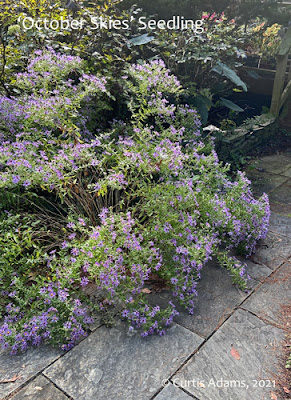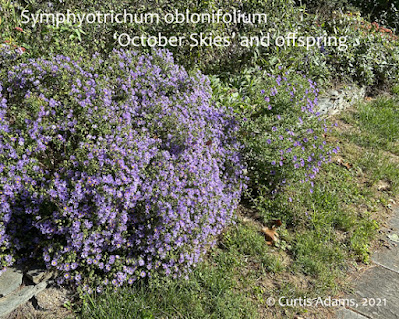What are Nativars?
Nativars are the subject of much discussion in the native plant community right now. The comments I've seen have ranged from mild interest to deep concern. I originally formed my opinion on these cultivated native plants over ten years ago. Before writing this post I thought I should do a little refresher on the subject and I learned that the world is a complicated place.
Nativar is not a true botanical term but rather a word coined by Robert Armitage for a cultivar of a native plant. It’s a combination of native, for native species, and cultivar. A cultivar is short for cultivated variety and is reproduced by asexual means, not from seed. Anytime you see a botanical name followed by a capitalized word (or words) in single quotes you are dealing with a cultivar. Alternatively, cultivars may be call using common names. For example Jim Dandy Winterberry Holly is the same thing as Ilex verticillata 'Jim Dandy'.
 |
| This is a wild type inkberry. I don't know how big this will get, but it should grow to 6-8' tall. Unlike the cultivars this one has few lower branches. |
Advantages of Nativars:
- May possess improved traits like disease resistance or improved blooming (size or quantity). For example, mildew resistance in phlox.
- Predictable performance
as design elements for color, shape and size. Size is particularly important when you are working close to structures. You can avoid a lot of maintenance pruning by electing a properly sized cultivar.
- Greater commercial availability as a result large scale, asexual reproduction.
- As a nursery propagated cultivar there is no risk that it was collected illegally from the wild.
- For dioecous species the gender is often known, e.g. male and female hollies. This is important if fruit production desired.
- Good introduction to native species for the novice.
Concerns about Nativars
There is concern that cultivated natives may not be as good of a food source for pollinators and herbivores. The potential impact is both on pollinator preference and acceptability as host plant. In some cases plant breeders have gotten creative and, in order to create some very interesting forms, have sacrificed ecological function. Examples of this include double coneflowers such as Echinacea 'Pink Double Delight' which does not produce significant amounts of nectar, pollen or seeds. There is also evidence that unusual colored foliage, particularly reddish, is less attractive to larval insects.
 |
| This wild-type purple coneflower grew from seed. Its parents were about 10' away. It is 'fully functional' producing pollen, nectar and seeds. |
When you get into the details of a native ecosystems it can get complicated. Native insects depend on plants, mostly native ones, for food. This food consists of not only the pollen and nectar from flowers that everyone loves, but also on the leaves, stems and other plant parts that not our focus when we think of how we want to support our insects. Insects consuming biomass is a key step in how sunlight is able to nourish all life on earth. Insects convert plant matter into a higher protein form that that is consumed by retiles, birds and other small predators, particularly those that are feeding their young. These first line predators then supply food energy for larger predators and so on. If these insects are not able to survive then the food web comes crashing down.
As clones, nativars lack the genetic diversity of wild-type, seed-grown plants. In sufficient quantity the cloned population may have an adverse effect on the wider eco-system. This may be from introducing either under or over-performing traits to the population. This possibility of introducing an overly advantageous trait is an aspect I had not considered, an example of which was brought out in an article found on the University of Maryland Extension website by Dr. Sara Tangren which identifies many of these issues around nativars. The article cites a case where the stronger growth habit of 'Shelter' switch grass, Panicum virgatum 'Shelter', may allow it to out-compete other meadow species and throw off the ecological balance in that system.
One study out of the University of Delaware has shown clear evidence that as foliage color shifts from green to purple hues (increasing anthocyanin) that feeding by insect herbivores (e.g. caterpillars) decreases. Other features of cultivars like varigation, fall color, disease resistance, habit and fruit size did not significantly affect how insects fed with these plants compared with their wild type relatives. This would be a factor in choosing among the new red-leafed ninebark cultivars. This study was focused on insect feeding on woody plants and did not get into pollinator behavior.
A much more positive spin on nativars can be found in this article from Nursery Management Magazine by Jolene Hansen. It cites the findings in the University of Delaware study.
An article by Rhonda Burnett and Carol Davit on the Grow Native! website also takes a cautious and critical view of nativars. But it also offers one of the best, though least satisfying, answers to the use of nativars, from Douglas Tallamy, "It depends."
Problem is when there is an imbalance. Questions to ask: Will my planting adversely affect the surrounding ecosystem? Is there a local native population that may be affected. What is the scale of my installation. Is it a single clone or is it from open pollinated seeds? Another quote from Dr. Tallamy (from the GrowNative! article) is the assertion that “It’s not the presence of cultivars, but the absence of natives that’s a problem.”
A major concern with cloned native species is their lack of genetic diversity. The question is whether a large-scale injection of one set of genes will negatively impact the larger population. This impact may be seen as a change in the native population or as a loss diversity leading to a decreased ability to adapt to environmental changes. Plant genetics is complicated. In many cases observable traits are passed on by the interaction of multiple genes.
To make this issue even more complicated consider that many nativars and hybrids do not reproduce true to type (if they can reproduce at all). Anecdotal evidence from my yard is that seedlings from 'October Skies' aromatic aster, Symphyotrichum oblonifolium 'October Skies' have very different forms. One is gangly and another is nicely rounded but about 50% larger. To my knowledge there are no other aromatic asters within 200 yards or mine (probably further). So these are probably the result of self pollination. So despite this being a cultivar, there is still a lot of variability packed into its genes. I watched the insects visiting the flowers, there was no obvious preference among the three plants. One advantage of having both was that the effective bloom time was increased over just having a single plant.
 |
| This is the first seedling I got from the original planting of October Skies. It is about 25% taller, floppier and blooms a little later than its parent. |
How and when to use Nativars
For many residential gardeners in urban and suburban developments there may not be much of a remnant ecosystem nearby that would be adversely effected by your plant choice. Closer to natural areas and especially when doing large scale restoration work, using locally adapted, or even locally sourced plant (local ecotype) material becomes much more critical. There are several companies that can help with suppling large quantities local plants. For example Ernst Conservation Seeds, Cardno, Carolina Native Plant Nursery, and Archewild. When concerned use seed grown native species from local eco-types. This is easy to say but much harder to do.
At this time there are
many more questions than answers, but studies are underway to begin to answer
some of these concerns. Based on examples of disastrous plant
introductions such as kudzu and Japanese knotweed it is understandable to be
cautious when introducing new plant materials, especially when we are doing it
in quantity and for what we believe is a 'good reason'.
For me, in my rural location I will the following guidelines.
- Within 50' of my house where design aspects such as color, shape and particularly size are important, cultivars are fine to use.
- As I move outside that designed space I will use mostly wild-type or straight species. Most, if not all of these are seed grown and are species native to this ecoregion (foothills of the Blue Ridge Mountains).
- As I get into natural spaces I try to avoid adding any new species not already present in the area. In many cases I am just managing the native species that are existing on-site (or have blown in) and most of the work involved is the removal of undesired and invasive species.
So I've written a lot of
words but I'm afraid the conclusion comes down to the less than satisfying 'it
depends'.







